
CART vs. F1
Atlas F1 Contributing Writer
It was a showdown anticipated for years; the two rivals had to be measured against each other at some point. Last weekend, it finally happened: CART competed, for the first time ever, on the same track as Formula One. The venue was Montreal's Circuit Gilles Villeneuve. The result: CART's pole time was 6.5 seconds slower than Formula One's. But is that it? Does that number really tell the whole story? Ross Stonefeld analyses the outcome, makes the inevitable comparison and explores the differences between the two series
As the only two top-tier open-wheel racing leagues in the world, and F1's perceived status as the pinnacle of motorsport, questions about the differences between the two series were going to be raised early and often and were further fuelled by the steady stream of drivers between the two leagues. With top drivers going both directions, the emphasis was less on who had the best drivers but rather who ran the fastest cars. It was all speculation, punctuated with rumors and legend of a Penske test at Silverstone in the early 90's. But it all came to a head last weekend.
Prior to 2001, the FIA regulations did no favors to CART, limiting what tracks it could race on abroad so as to avoid any comparison to Formula One. Following a European Union investigation, the FIA agreed to remove itself from the commercial interest in the success of F1 and become an impartial regulator of motorsport.
This paved the way for "the introduction of new and competing forms of motorsport and creating new possibilities for circuits and broadcasters"; which brought CART to Montreal - to the Circuit Gilles Villeneuve, just over two months after the Formula One circus ran the Canadian Grand Prix on the very same layout.
Two series, one track, one season, one question: who's faster?
The simple reply was: Formula One, by six and a half seconds no less. Da Matta's pole time from Sunday was some 6.5 seconds behind Juan Pablo Montoya's F1 pole time of 1:12.386 at June this year. It was even slower than the slowest time - 1:17.347 - set in F1 qualifying, by Minardi's Alex Yoong.
But the simple reply hardly tells the full story, and the bare facts couldn't possibly offer a genuine answer to the burning question of the day.
Furthermore, in CART Lola is dominating the chassis war in both speed and strength of numbers, with Reynard fielding fewer entrants after its recent financial crisis. All teams race on identical Bridgestone Potenza slicks and can choose from Ford, Toyota, or Honda engines. But how do they differ from the F1 cars? The table below outlines their basic dimensions.
I had the opportunity to speak with Peter Gibbons, Chief Engineer for the Halvoline and Eli Lilly Lola-Toyotas for Christiano da Matta and Christian Fittipaldi. With 6 poles from 13 starts, Gibbons is arguably the final word when it comes to honing the setup of a ChampCar. His assistance was crucial in breaking down how the technical differences between the two series affected lap times.
The most obvious and most telling difference is the weight. Even with one of the smallest drivers in the CART series, the ChampCar pole sitter outweighed Montoya's BMW-Williams by almost 400 pounds.
Carbon fiber brakes are legendary for their almost-too-late stops and it is assumed they have more 'bite' than their metal counterpart. However, this is simply not the case. The biggest advantage in carbon fiber rotors is, again, the weight. A lighter rotor needs less power to decelerate, which lends itself to such impressive stopping power. It has a secondary benefit of lowering the unsprung weight in each corner of the car, providing a benefit in cornering and a lighter feel of the steering.
Moreover, the ChampCar is physically larger than the F1 car, adding more drag. Additionally, the ratio of drag-to-downforce as speeds increase is not in favor of the ChampCar. In simple English: it's not as slippery through the air at the same level of downforce as an F1 car.
F1 utilizes the four grooved 'slick' tire whilst CART runs on the more classic smooth slick. On basic theory the lower surface area of the grooved tire should make it less grippy, but due to the tire war and the commitment of the tire manufacturers the F1 tire it a very developed one, contrasted to the CART rubber which is somewhat 'off the shelf' from single tire supplier Bridgestone.
Both cars use traction control, but in different ways. F1 uses an electric 'fly by wire' throttle much like a set of video game controls, using electronic signals to operate the engine instead of the traditional throttle cable as used in CART. There is a difference in the efficiency of the traction control under each system and while the difference is negligible, the advantage is in F1's favour.
The ability to ride the kerbs is crucial to any racing vehicle. It allows for a larger arc through the turn and ultimately more speed. Formula One cars must run a very stiff suspension to control their aerodynamics because of a phenomenon known as pitch-sensitivity. The height of the chassis is as crucial to downforce as the wing angle itself. The over simplified theory is that the lower the wing is, the more it pulls the car into the road. The logic behind the FIA plank is that it keeps the teams from running too low and creating too much downforce. It's a simple and cheap way to keep the speeds down.
In a Formula One car, there are three main points of aerodynamic grip, namely the main wings and diffuser. The diffuser is located just behind the rear axle and under the rear wing. Pitch occurs when one end of the car changes its ride height, and downforce, relative to the opposite end. In effect, the car becomes an aerodynamic see-saw as the center point of the grip moves along the car as it pitches forward and back and can be unsettling in the brake zone and corners.
A ChampCar has the same front and rear wings as its F1 cousin, but produces underbody downforce in a very different way. Instead of a diffuser at the rear of the car, the floor of the car itself is shaped like an inverted wing, accelerating the airflow to make the entire body create downforce. Because it is more centrally located in the car's wheelbase, the see-saw effect is lessened under pitch. This means a softer suspension can be used, which leads to more compliance over bumps and kerbing.
Watching the Montreal qualifying, the ChampCars didn't exhibit any of the normal caffeine-laden twitchiness of an F1 car through the chicanes, but sublimely glided over each kerb. It would be interesting to see how much closer, if at all, the ChampCar would be to F1 on a bumpy street circuit.
So what has all this come down to?
Below are the best sector and speed trap times from qualifying in each series, creating a theoretical 'ultimate' lap. True F1 pole was 1:12.836 (+0.259) by Juan Pablo Montoya and true CART pole was set by Christiano Da Matta at 1:18.959 (+0.291).
After the debate over lap times, the second biggest question was who would put on the better race.
Much has been made of the competitiveness of each series and the table below illustrates that while the larger F1 field has a greater spread of times, matched car for car both series are quite similar.
This shows that two series with differing views on engineering, but with competent teams can achieve a similar depth of the field. This was also reflected in the race itself, as both divisions had their moments of excitement and their moments of terrifying boredom, but neither stood out over the other.
But at what price does F1's performance advantage is obtained? Grand Prix budgets are staggering in size, although it again comes down to the philosophy of the series - preparation of an existing chassis-engine-tire combination versus an all-out prototype battle. F1 budgets are well documented, but CART is more difficult to quantify.
A team the strength of Newman/Haas can sell title sponsorship for one of its cars in the $10-$15 million a year range. However, this is far from the complete budget. Being a front running team Newman/Haas enjoys an engine partnership on par with a Formula One team. They receive free engines and technical support from Toyota and receive additional funds from Toyota for the privilege and exposure of supplying the team. This is not a public figure, though it could be guessed at.
Throw in secondary sponsorship, prize money, and that Carl Haas is the Lola importer for North America and the budget per car could easily double the quoted price. Suddenly a front running 2 driver CART effort isn't that far behind Minardi in budget, or speed. Both teams will test perhaps 20 or even 30 times in a season. In the case of Minardi it's a financial woe, but in CART it's down to heavy testing restrictions. Compare that with the 143 days spent on track by the BMW-Williams test team this season alone!
The cost differences between the front running teams in both series is not an indication of quality, but one of rules and vision. One thing is for certain, though: it takes money to go fast and it's a question of how much you're willing to pay. For the sharp end of the CART and F1 grid the answer is simple: As much it takes.
It was going to happen eventually, it just had to. On Saturday, August 24th 2002, Brazilian driver Cristiano da Matta secured pole position for CART's Montreal Indy race, setting a time of one minute, 18.959 seconds. The significance of this event, though, had little to do with who set the pole position, but rather where and how fast it was set.
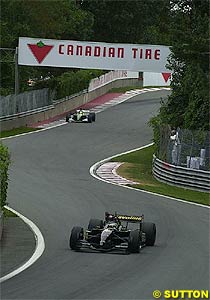 Founded in 1978 as an organization to represent USAC ChampCar team owners, CART held its first race on an oval in Phoenix the following year. It was inevitable that the series would draw comparisons with Formula One as it added road courses to its schedule and drew teams from the then defunct Can-Am series in the mid-80s.
Founded in 1978 as an organization to represent USAC ChampCar team owners, CART held its first race on an oval in Phoenix the following year. It was inevitable that the series would draw comparisons with Formula One as it added road courses to its schedule and drew teams from the then defunct Can-Am series in the mid-80s.
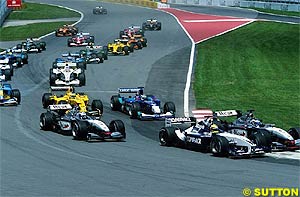 For one, much has been made of the technical differences between the cars and how they would affect the eventual performance of both formulas. The two series have very different approaches to the technical regulations, but both are restrictive. Formula One's emphasis is on engineering and developing a one of a kind race car, whilst CART challenges its teams to focus on getting the maximum out of one of several available combinations.
For one, much has been made of the technical differences between the cars and how they would affect the eventual performance of both formulas. The two series have very different approaches to the technical regulations, but both are restrictive. Formula One's emphasis is on engineering and developing a one of a kind race car, whilst CART challenges its teams to focus on getting the maximum out of one of several available combinations.
ChampCar
Formula One
Weight
703kg (not including driver)
600 kg (including driver)
Height
914 mm/36 in
950 mm/37.4 in
Width
1994 mm/78.5 in
1800 mm/70.9 in
Wheelbase
3035 mm/119.5 in
3020 mm/ 118.9 in
Engine
2.65 Litre V8 Turbo
3.0 Litre V10
Power
850hp (est)
850hp (est)
Gearbox
6 or 7 speed sequential with flat-shift capability
6 or 7 speed semi-automatic
Fuel
Methanol
Unleaded Petrol
Tires
10” Front 14” Rear
14” Front 15” Rear
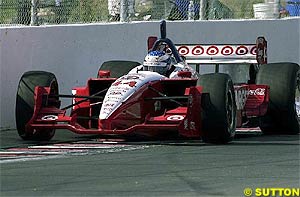 Weight is one of the most critical aspects of a car's performance as it affects every range of its performance window. A heavy car will brake earlier, corner slower, and accelerate with less gusto. It is estimated by the Newman/Haas engineering staff that this weight difference accounts for 3.5 seconds per lap. It is the single largest penalty in the car's performance and the remaining lost time is located in the finer details.
Weight is one of the most critical aspects of a car's performance as it affects every range of its performance window. A heavy car will brake earlier, corner slower, and accelerate with less gusto. It is estimated by the Newman/Haas engineering staff that this weight difference accounts for 3.5 seconds per lap. It is the single largest penalty in the car's performance and the remaining lost time is located in the finer details.
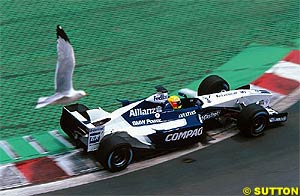 What all this means is that the Grand Prix racer is going through each corner faster, carrying that speed onto the next straight, accelerating better, and carrying more of that speed into the next corner. The F1 machine extends its lead in each section of the track but there is one area that the ChampCar is more favorable and perhaps even better.
What all this means is that the Grand Prix racer is going through each corner faster, carrying that speed onto the next straight, accelerating better, and carrying more of that speed into the next corner. The F1 machine extends its lead in each section of the track but there is one area that the ChampCar is more favorable and perhaps even better.
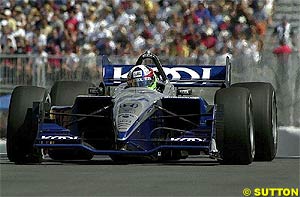 One area a Champcar would be unmatched is a high speed oval. The cars are completely changed visually, running special engines and paper-thin wings that make Monza look like a high grip circuit. An F1 car would simply not be in its element in the ChampCar's natural hunting ground, and from a safety standpoint would simply not be suited to high speed impact.
One area a Champcar would be unmatched is a high speed oval. The cars are completely changed visually, running special engines and paper-thin wings that make Monza look like a high grip circuit. An F1 car would simply not be in its element in the ChampCar's natural hunting ground, and from a safety standpoint would simply not be suited to high speed impact.
Sector 1 Time
Sector 1 Speed
Sector 2 Time
Sector 3 Time
Start/Finish Speed
Total Lap Time
Average Speed
F1
20.415
172.4mph
23.237
28.925
187.3mph
1:12.577
135.1mph
CART
21.815
163.3mph
24.992
31.861
169.6mph
1:18.668
124.7mph
Difference
1.4
9.1
1.755
2.936
17.7
6.091
10.4
%
6.8
5.5
7.5
10.1
10.4
8.4
8.4
F1
CART
Fastest
1:12.836
1:18.959
Slowest
1:17.347
1:21.670
Difference
4.511
2.711
%
106.193
103.4
Second Slowest
1:15.508
1:21.067
Difference
2.672
2.108
%
103.6
102.6
17th
1:15.102
1:21.067
Difference
2.266
2.108
%
103.1
102.6
Please Contact Us for permission to republish this or any other material from Atlas F1.
|
Volume 8, Issue 35
Articles
A Question of Speed: CART vs. F1
Civil War of Motorsports: CART vs. IRL
Jo Ramirez: a Racing Man
Belgian GP Preview
The Belgian GP Preview
Local History: Belgian GP
Belgium Facts, Stats & Memoirs
Columns
The Belgian GP Quiz
Bookworm Critique
Elsewhere in Racing
The Grapevine
> Homepage |